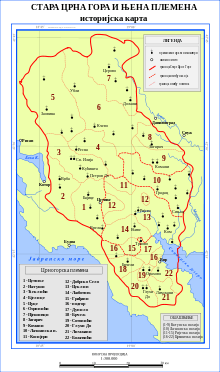Bjelice
| Current region | Montenegro |
|---|

Bjelice (Serbian: Бјелице/Bjelice) is a historical region and tribe of the Katunska nahija of Old Montenegro.[1] The tribe was one of the largest traditional tribes of Old Montenegro and one of nine tribes of the Katunska nahija, along with Cetinje, Njeguši, Ćeklići, Cuce, Ozrinići (Čevo), Pješivci, Zagarač and Komani.
Geography
The Bjelice region is located 20–50 km northwest of Cetinje. It is of a relatively high altitude (800–900 meters above sea level) and is surrounded by high mountains – Čelinac, Štavor and Čevski lisac. Today, Bjelice is considered a geographic region corresponding to the territory of the traditional tribe.
History
Czech historian Konstantin Jireček noted that Bjelice was first mentioned as a territory around 1430 ("de zente Bielice"). They are also mentioned in a 1431 document found in the Kotor Archives, and in the Ottoman defter (tax registry) from 1521. Bjelice are described as a village comprising 80 houses and four hamlets: Lješev Stup (Lješev Stub), Prediš, Rešna (Resna) and Staković. It is believed that Bjelice, along with the clans (brotherhoods) of Cuce and Bajice, are the descendants of the Orlović clan. Pavle Orlović is a Serb legendary hero who fell at the Battle of Kosovo (1389), which legend holds that these clans are his descendants, it is likely it was from his brothers (as there are no written records of him having any descendants). The Orlović flight from Kosovo before the advancing Ottomans had them settle in around Gacko and neighboring villages (Čarađe, Bjeletaci). They later moved to Banjani and finally to the territory of Old Montenegro.
In 17th century Ceklin tribe expelled Bjelice from the territory they inhabit today (around Skadar Lake and Rijeka Crnojevića).[2][3]
In 1829 Bjelice struggled against Ozrinići and Cuce, two neighboring tribes, and Petar I Petrović-Njegoš sent Sima Milutinović Sarajlija and Mojsije to negotiate peace among them.[4]
Anthropology
Brotherhoods
The Bjelice tribe was divided into Upper (Gornje) Bjelice and Lower (Donje) Bjelice. Like most tribes, it was also consisted of numerous brotherhoods and families. The largest brotherhood was Milić. Older brotherhoods are also Abramović, Andrić, Pejović, Kuzman, Popivoda, Tomić and Mikulić while there are also a number of younger brotherhoods. Many emigrants from the tribe took Bjelica for their surname.
References
- ↑ Историски записи. с.н. 1960. p. 394. Retrieved 7 May 2013.
Опште је познато да су Бјелице племе Катунске нахије...
- ↑ Zarij M. Bešić (1975). Istorija Črne Gore: Od poěetka XVI do kraja XVIII vijeka. pts. Red. za istoriju Črne Gore. p. 475. Retrieved 7 May 2013.
Цеклињани су тек у XVII стољећу успјели да истисну Бјелице са своје данашње територије.
- ↑ Vojislav Đurić (1972). Naučnici. Matica srpska. p. 125. Retrieved 7 May 2013.
На исти начин су истерани... из Цеклина Бјелице
- ↑ Miloš Oben; Michel Aubin (1989). Njegoš i istorija u pesnikovom delu. Književne novine. p. 63. Retrieved 7 May 2013.
Бјелице су племе у Катунској нахији. Водили су 1829. оружану бор- бу са два суседна племена, Озринићима и Цуцама. Да би успоставио мир, Петар I је решио да им пошаље Симу Милутиновића и Мојсија
Notable people
- Marina Abramović, New York-based Serbian-Montenegrin performance artist.
- Dimitrije Bjelica, Serbian chess FIDE Master and journalist.
- Isidora Bjelica, Serbian prose writer.
- Nemanja Bjelica, Serbian basketball player.
- Milko Bjelica, Montenegrin basketball player.
- Ana Bjelica, Serbian volleyball player, sister of above-mentioned Milko
- Novica Bjelica, Serbian volleyball player
- Milan Bjelica, Deputy Chief of Serbian General Staff of the Serbian Armed Forces
- Danilo Popivoda, former Serbian-born Slovenian footballer
- Srđan Milić, Montenegrin politician
- Srđan Mrvaljević, Montenegrin judoka
- Željko Mrvaljević, Montenegrin footballer
- Miloš Mrvaljević, Montenegrin footballer
- Draško Mrvaljević, Montenegrin handball player
- Marijana Goranović, Montenegrin Paralympic shot putter
